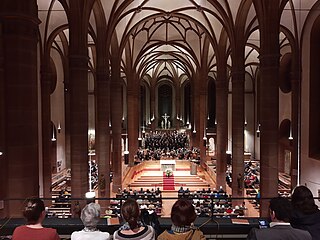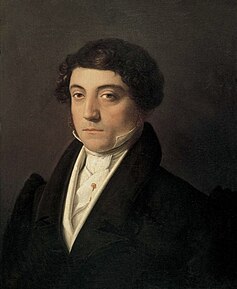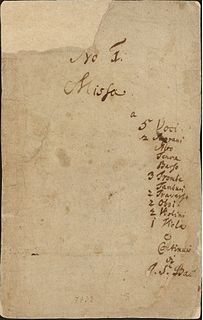Related Research Articles

Giovanni Battista Draghi, often referred to as Giovanni Battista Pergolesi, was an Italian Baroque composer, violinist and organist. His best-known works include his Stabat Mater and the opera La serva padrona. His compositions include operas and sacred music. He died of tuberculosis at the age of 26.
William Cornysh the Younger was an English composer, dramatist, actor, and poet.
Antonio Vivaldi wrote at least three settings of the hymn Gloria in excelsis Deo, whose words date probably from the 4th Century and which is an integral part of the Ordinary of the Mass. Two survive: RV 588 and RV 589. A third, RV 590, is mentioned only in the Kreuzherren catalogue and presumed lost. The RV 589 Gloria is a familiar and popular piece among sacred works by Vivaldi. It was probably written at about the same time as the RV 588, possibly in 1715.

Karol Szymanowski's Stabat Mater, Op. 53, was composed in 1925 to 1926 for soprano, alto and baritone soloists, SATB choir, and orchestra. The work is divided into six movements and uses Jozef Janowski's (1865–1935) Polish translation of the Marian hymn, Stabat Mater.
Stabat Mater, FP 148, is a musical setting of the Stabat Mater sequence composed by Francis Poulenc in 1950. Poulenc wrote the piece in response to the death of his friend, artist Christian Bérard; he considered writing a Requiem for Bérard, but, after returning to the shrine of the Black Virgin of Rocamadour, he selected the medieval Stabat Mater text. Poulenc's setting, scored for soprano solo, mixed chorus, and orchestra, premiered in 1951 at the Strasbourg Festival. The Stabat Mater was well received throughout Europe, and in the United States it won the New York Critics' Circle Award for Best Choral Work of the year.

The Quattro pezzi sacri are choral works by Giuseppe Verdi. Written separately during the last decades of the composer's life and with different origins and purposes, they were nevertheless published together in 1898 by Casa Ricordi. They are often performed as a cycle, not in chronological sequence of their composition, but in the sequence used in the Ricordi publication:

Antonín Dvořák's Stabat Mater, Op. 58 (B. 71), is an extended setting for vocal soloists, choir and orchestra of the 20 stanzas of the Stabat Mater sequence. Dvořák sketched the composition in 1876 and completed it in 1877. It has been characterized as a sacred cantata and as an oratorio, and consists of ten movements of which only the first and the last are thematically connected. Its total performance time is around 85 minutes.CITEREFantonin-dvorak.cz2019
Joseph Haydn's Stabat Mater Hob. XXa:1 was written in 1767, for soprano, alto, tenor and bass soloists, mixed choir, 2 oboes both doubling English horn in the sections in E-flat major, strings and organ continuo. The first performance is believed to have taken place March 25, 1768 in Vienna with soloists Anna Maria Scheffstoss and Carl Friberth, with Haydn conducting from the harpsichord. Conductor Jonathan Green suggests adding a bassoon to double the bass line and perhaps just one player to each string part.

Stabat Mater is a work by Gioachino Rossini based on the traditional structure of the Stabat Mater sequence for chorus and soloists. Initially he used his own librettos and compositions for a portion of the work and, eventually, the remainder by Giovanni Tadolini, who composed six additional movements. Rossini presented the completed work to Varela as his own. It was composed late in his career after retiring from the composition of opera. He began the work in 1831 but did not complete it until 1841.

Messiah, the English-language oratorio composed by George Frideric Handel in 1741, is structured in three parts. This listing covers Part III in a table and comments on individual movements, reflecting the relation of the musical setting to the text. Part I begins with the prophecy of the Messiah and his birth, shows the annunciation to the shepherds as a scene from the Gospel of Luke, and reflects the Messiah's deeds on Earth. Part II covers the Passion, death, resurrection, ascension, and the later spreading of the Gospel. Part III concentrates on Paul's teaching of the resurrection of the dead and Christ's glorification in heaven.

The Mass in B minor is Johann Sebastian Bach's only setting of the complete Latin text of the Ordinarium missae. Towards the end of his life, mainly in 1748 and 1749, he finished composing new sections and compiling it into a complex, unified structure.

Vesperae solennes de confessore, K. 339, is a sacred choral composition, written by Wolfgang Amadeus Mozart in 1780. It is scored for SATB choir and soloists, violin I, violin II, 2 trumpets, 3 trombones colla parte, 2 timpani, and basso continuo.
Stabat Mater (P.77) is a musical setting of the Stabat Mater sequence, composed by Giovanni Battista Pergolesi in 1736. Composed in the final weeks of Pergolesi's life, it is scored for soprano and alto soloists, violin I and II, viola and basso continuo.

Stabat Mater in F minor, D 383, is a musical setting of the Stabat Mater sequence, composed by Franz Schubert in 1816. It is scored for soprano, tenor and bass soloists, SATB choir, 2 flutes, 2 oboes, 2 bassoons, contrabassoon, 2 french horns, 3 trombones, violin I and II, viola, cello and double bass.

Antonio Vivaldi made several versions of his G minor setting of the Magnificat canticle. He scored his best known version, RV 610, for vocal soloists, four-part choir, oboes and string orchestra, which also exists in a version for two groups of performers. He based these versions on an earlier setting for voices and strings only (RV 610b). His ultimate version, in which some choral and ensemble movements are replaced by five arias, to be sung a cappella by girls from the Ospedale della Pietà orphanage, was catalogued as RV 611. The concise work is well suited for use in vesper services.

Der Messias, K. 572, is Wolfgang Amadeus Mozart's 1789 German-language version of Messiah, George Frideric Handel's 1741 oratorio. On the initiative of Gottfried van Swieten, Mozart adapted Handel's work for performances in Vienna.
The Missa secundi toni is a mass by Johann Ernst Eberlin. He wrote it for the Salzburg Cathedral, and scored it for four soloists, a four-part choir, two violins and continuo.
Antonio Vivaldi composed several settings of the Dixit Dominus, the Latin version of Psalm 110. They include a setting in ten movements for five soloists, double choir and orchestra, RV 594, another setting in eleven movements for five voices, five-part choir and orchestra, RV 595, and a recently discovered setting in eleven movements for five soloists, choir and orchestra, RV 807, which had been attributed to Baldassare Galuppi. It is said to be one of his "most significant sacred works."

Alessandro Scarlatti's Stabat Mater is a religious musical work composed for two voices (soprano/alto), two violins and basso continuo, in 1724, on a commission from the Order of Friars Minor, the "Knights of the Virgin of Sorrows" of the Church of San Luigi in Naples for Lent

The Litany to the Virgin Mary, Op. 59, is a sacred choral composition by Karol Szymanowski, written from 1930 to 1933 and scored for soprano soloist, a women's choir, and orchestra. The work is divided into two movements on a Polish text of the Litany to the Virgin Mary by Jerzy Liebert. Dedicated to Anna Iwaszkiewiczowa, it was first performed in 1933, conducted by Grzegorz Fitelberg. The work was first published in 1951.